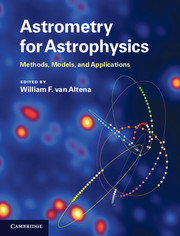Book contents
- Frontmatter
- Contents
- List of contributors
- List of acronyms
- Preface
- Part I Astrometry in the twenty-first century
- Part II Foundations of astrometry and celestial mechanics
- Part III Observing through the atmosphere
- 9 The Earth's atmosphere: refraction, turbulence, delays, and limitations to astrometric precision
- 10 Astrometry with ground-based diffraction-limited imaging
- 11 Optical interferometry
- 12 Radio astrometry
- Part IV From detected photons to the celestial sphere
- Part V Applications of astrometry to topics in astrophysics
- Index
- References
12 - Radio astrometry
from Part III - Observing through the atmosphere
Published online by Cambridge University Press: 05 December 2012
- Frontmatter
- Contents
- List of contributors
- List of acronyms
- Preface
- Part I Astrometry in the twenty-first century
- Part II Foundations of astrometry and celestial mechanics
- Part III Observing through the atmosphere
- 9 The Earth's atmosphere: refraction, turbulence, delays, and limitations to astrometric precision
- 10 Astrometry with ground-based diffraction-limited imaging
- 11 Optical interferometry
- 12 Radio astrometry
- Part IV From detected photons to the celestial sphere
- Part V Applications of astrometry to topics in astrophysics
- Index
- References
Summary
Introduction
Astrometry is the branch of astronomy that studies the position and motion of celestial objects in the Solar System, in the Milky Way Galaxy, and for galaxies that are near the limit of the observable Universe. In radio astronomy, the study can be separated into microastrometry and macro-astrometry. Micro-astrometry deals with the motion of individual or a small number of associated objects in order to determine their space motion, their distance from the Solar System, and their kinetic properties with respect to neighboring stars and planets. The observational techniques and reductions measure the separation of the target object from a nearby calibrator radio source with known and stable properties.
Macro-astrometry, on the other hand, deals with the absolute position of radio sources, which also requires the determination of the Earth's deformations, complex rotations, and space motion. This type of astrometric experiment observes many well-known compact radio sources over the sky within a 24-hour period. From the analysis of systematic residuals in the data, the absolute positions of the sources, as well as the astrometric and geodetic properties the Earth, are determined. From this 30+ year effort, the fundamental celestial inertial frame has been defined to an accuracy of about 0.01 milliarcsec (mas) using the position of nearly 300 radio sources.
For nearly 30 years, the highest astrometric precision has been obtained using radio-interferometric techniques because of several properties of radio waves. First, astronomers and engineers have been able to connect arrays of radio telescopes that span the Earth (even into Earth orbit) to achieve resolutions of a few mas and obtain positional accuracies well under 1 mas.
Information
- Type
- Chapter
- Information
- Astrometry for AstrophysicsMethods, Models, and Applications, pp. 175 - 198Publisher: Cambridge University PressPrint publication year: 2012
References
Accessibility standard: Unknown
Why this information is here
This section outlines the accessibility features of this content - including support for screen readers, full keyboard navigation and high-contrast display options. This may not be relevant for you.Accessibility Information
- 2
- Cited by
